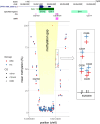Differential methylation of OPRK1 in borderline personality disorder is associated with childhood trauma
- PMID: 38862675
- PMCID: PMC11609100
- DOI: 10.1038/s41380-024-02628-z
Differential methylation of OPRK1 in borderline personality disorder is associated with childhood trauma
Abstract
According to a growing body of neurobiological evidence, the core symptoms of borderline personality disorder (BPD) may be linked to an opioidergic imbalance between the hedonic and stimulatory activity of mu opioid receptors (MOR) and the reward system inhibiting effects of kappa opioid receptors (KOR). Childhood trauma (CT), which is etiologically relevant to BPD, is also likely to lead to epigenetic and neurobiological adaptations by extensive activation of the stress and endogenous opioid systems. In this study, we investigated the methylation differences in the promoter of the KOR gene (OPRK1) in subjects with BPD (N = 47) and healthy controls (N = 48). Comparing the average methylation rates of regulatorily relevant subregions (specified regions CGI-1, CGI-2, EH1), we found no differences between BPD and HC. Analyzing individual CG nucleotides (N = 175), we found eight differentially methylated CG sites, all of which were less methylated in BPD, with five showing highly interrelated methylation rates. This differentially methylated region (DMR) was found on the falling slope (5') of the promoter methylation gap, whose effect is enhanced by the DMR hypomethylation in BPD. A dimensional assessment of the correlation between disease severity and DMR methylation rate revealed DMR hypomethylation to be negatively associated with BPD symptom severity (measured by BSL-23). Finally, analyzing the influence of CT on DMR methylation, we found DMR hypomethylation to correlate with physical and emotional neglect in childhood (quantified by CTQ). Thus, the newly identified DMR may be a biomarker of the risks caused by CT, which likely epigenetically contribute to the development of BPD.
© 2024. The Author(s).
Conflict of interest statement
Competing interests: The authors declare no competing interests.
Figures


Similar articles
-
Association between methylation of the glucocorticoid receptor gene, childhood maltreatment, and clinical severity in borderline personality disorder.J Psychiatr Res. 2014 Oct;57:34-40. doi: 10.1016/j.jpsychires.2014.06.011. Epub 2014 Jul 1. J Psychiatr Res. 2014. PMID: 25048180
-
Methylation of the dopamine D2 receptor (DRD2) gene promoter in women with a bulimia-spectrum disorder: associations with borderline personality disorder and exposure to childhood abuse.J Psychiatr Res. 2014 Jan;48(1):121-7. doi: 10.1016/j.jpsychires.2013.10.003. Epub 2013 Oct 12. J Psychiatr Res. 2014. PMID: 24157248
-
Pathoetiology and pathophysiology of borderline personality: Role of prenatal factors, gut microbiome, mu- and kappa-opioid receptors in amygdala-PFC interactions.Prog Neuropsychopharmacol Biol Psychiatry. 2020 Mar 2;98:109782. doi: 10.1016/j.pnpbp.2019.109782. Epub 2019 Nov 2. Prog Neuropsychopharmacol Biol Psychiatry. 2020. PMID: 31689444 Review.
-
Methylation of BDNF in women with bulimic eating syndromes: associations with childhood abuse and borderline personality disorder.Prog Neuropsychopharmacol Biol Psychiatry. 2014 Oct 3;54:43-9. doi: 10.1016/j.pnpbp.2014.04.010. Epub 2014 May 5. Prog Neuropsychopharmacol Biol Psychiatry. 2014. PMID: 24801751
-
Understanding the genetics and epigenetics of bulimia nervosa/bulimia spectrum disorder and comorbid borderline personality disorder (BN/BSD-BPD): a systematic review.Eat Weight Disord. 2019 Oct;24(5):799-814. doi: 10.1007/s40519-019-00688-7. Epub 2019 May 22. Eat Weight Disord. 2019. PMID: 31119586 Free PMC article.
References
-
- Bohus M, Stoffers-Winterling J, Sharp C, Krause-Utz A, Schmahl C, Lieb K. Borderline personality disorder. Lancet. 2021;398:1528–40. 10.1016/S0140-6736(21)00476-1. - PubMed
-
- Schmahl C, Herpertz SC, Bertsch K, Ende G, Flor H, Kirsch P, et al. Mechanisms of disturbed emotion processing and social interaction in borderline personality disorder: state of knowledge and research agenda of the German Clinical Research Unit. Borderline Personal Disord Emot Dysregul. 2014;1:12. 10.1186/2051-6673-1-12. - PMC - PubMed
-
- Herpertz SC, Bertsch K, Jeung H. Neurobiology of criterion a: self and interpersonal personality functioning. Curr Opin Psychol. 2018;21:23–7. 10.1016/j.copsyc.2017.08.032. - PubMed
MeSH terms
Substances
LinkOut - more resources
Full Text Sources
Research Materials
Miscellaneous

